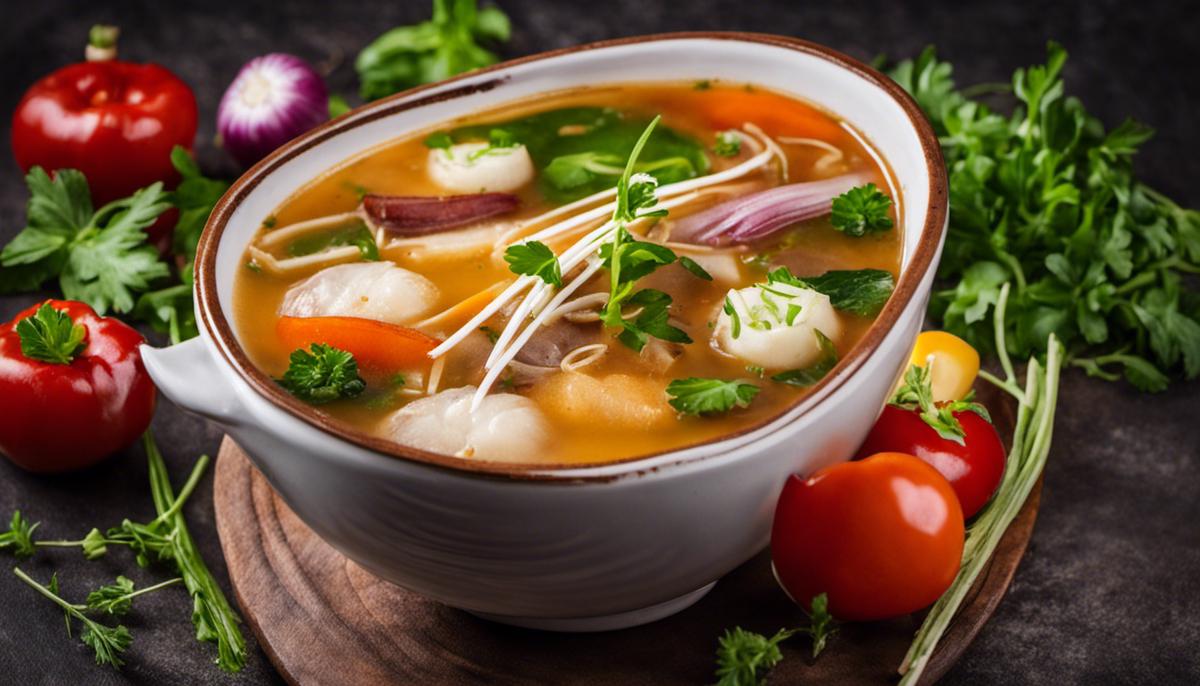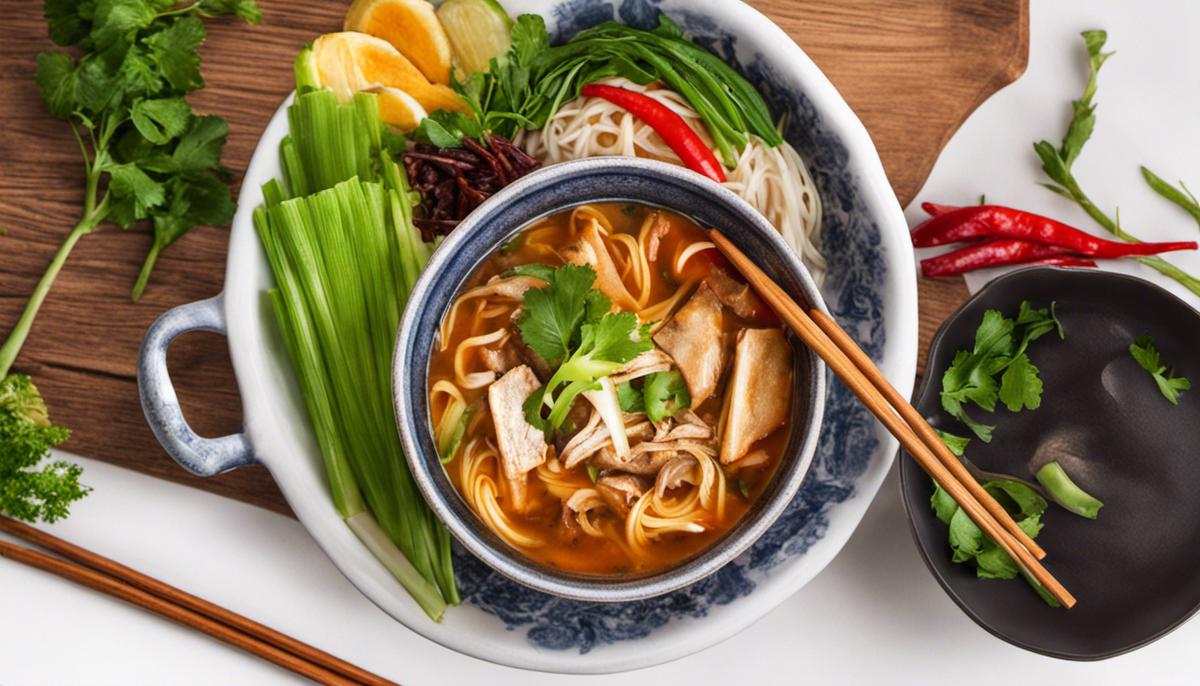Globally celebrated for its unique tangy flavor profile, Sour Soup is a beloved dish that transcends cultural and geographical boundaries. Tracing back its origins, one discovers a wealth of history laced with varied traditions that have culminated in the rich diversity of sour soup variations we see today. From time-tested ingredients to inventive adaptations, the world of sour soup offers a fusion of flavors that simultaneously comforts and tantalizes the palate. This enchanting exploration of sour soup will not just delve into its rich history and varied interpretations, but also highlight the methods of its preparation, its potential health benefits, and the best ways to serve and complement it.
History of Sour Soup
Origins of Sour Soup
Sour soup, as the name suggests, is a type of broth that is distinguished by its tangy, sour flavor profile. While the components and techniques of sour soup vary greatly due to regional cuisines, the concept of a tart, mouth-watering soup stretches back centuries, transcending geographical boundaries.
The origins of sour soups can be traced back to different parts of the world, from Asia to Europe, and the Americas. In Eastern Europe, for example, sour soup—or “zurek”—is a traditional dish often served during Easter in countries such as Poland. It’s made with fermented or soured grains, usually rye, that give it a distinctive tang. In the tropical archipelago of the Philippines, sinigang, a type of sour soup with tamarind as the key ingredient, is a hearty and popular comfort dish.
Influence of Geographical and Cultural Context on Sour Soup
The sourness in these soups typically comes from natural ingredients that contain acids. This includes lemons, limes, pineapples, vinegars, tamarind, tomatoes, and fermented substances. The geographical availability of these acidic ingredients largely determines the flavor profile of various regional sour soups. For example, in areas where tamarind is bountiful like Southeast Asia, it’s used as the primary souring agent in soups. In contrast, in regions where dairy is more accessible, such as Eastern Europe, sour cream becomes a main ingredient to contribute to the soup’s acidity.
Culture also plays a significant role in these variations. Traditional sour soup in Vietnam, known as “canh chua,” reflects the country’s balance of sour, sweet, salty, and spicy flavors, while the Russian “schi” depends on sour cabbage (sauerkraut) or sour rye flour for its distinct taste.
Contemporary Variations of Sour Soup
Many contemporary variations of sour soup now exist, thanks to the fusion of different culinary traditions. These versions incorporate a variety of meats, vegetables, and spices to cater to diverse palates. For instance, Tom Yum from Thailand is a hot and sour soup featuring shrimp and lemongrass. In the United States, Sour Shrimp Soup fuses elements from the American South with Vietnamese inspiration, using okra for thickness and lime juice for the characteristic tartness.
The growing interest in health and wellness has also influenced the development of sour soups. Many chefs and home cooks now incorporate a wide range of nutrient-rich vegetables and lean proteins, recognizing the soup’s potential to offer a hearty, satisfying dish that is also healthful.
Exploring the Global Variety of Sour Soup
Unpacking the international assortment of sour soup reveals a diverse and abundant culinary picture that spans across several cultures. This adaptable dish continues to adapt while catering to changing dietary trends and inventive cooking techniques. Yet amid this evolution, the soup retains its fundamental charm – an appetizing sour flavor that leaves an indelible mark on the palate.

Key Ingredients and Variations
Key Ingredients Determining the Flavor Profile of Sour Soups
Rooted in numerous cultural cuisines, the distinct tartness of sour soup comes from key acidic components. Many universal ingredients like tamarind, tomatoes, vinegar, or kimchi bring about its recognizable tang. The sweet-and-sour profile of tamarind, a tropical fruit, plays a critical role in Southeast Asian interpretations of the dish. On the other hand, the acidic, slightly sweet charm of tomatoes underpins some Eastern European renditions of sour soup. Vinegar serves as the principle souring agent for the Filipino favorite, Sinigang, whereas Korean renditions use fermented veggies, such as kimchi.
Each ingredient not only lends its unique flavor but also furthers the dish’s dietary merits. Tamarind, for example, is packed with beneficial nutrients like Vitamin C, while tomatoes and kimchi are lycopene-loaded, favoring heart health.
Exploring the World of Sour Soup
Sour soup, known for its tangy flavor, is a remarkable dish with its diverse variations across different regions and cultures. From Paleo to vegan variations, each flavor palette not only demonstrates versatility but also provides a glimpse into the culinary richness of the culture it stems from.
In the valleys of Vietnam, sour soup, known as Canh Chua, skillfully balances the notes of sour, sweet, and savory with fish, pineapple, and tomatoes simmered in a tamarind-based broth. This ensemble is often enjoyed with steamed white rice.
On the other hand, Zurek, a staple in Poland, introduces a different flavor profile. This sour soup, abundant with egg, sausage, and fermented rye flour, flaunts a rich and earthy sour-salty taste.
If you migrate further south, African cuisine presents a creamy Peanut Soup with a hint of sourness from tomatoes. Going by its name, it’s not just an amalgamation of flavors from peanuts but, interestingly, also includes a variety of meats, vegetables, and aromatic spices.
Lastly, in the Philippines, sour soup takes the form of Sinigang, featuring meat (often pork) with a variety of vegetables, stewed in a tamarind broth. The uniqueness of this dish lies in its adjustable sourness which can be tailored according to individual preferences.
These examples highlight the impressive diversity of sour soup. It can be a wistful, tangy broth devoured in the East, or wholesome, substantial versions relished in the West and Africa, affirming that the realm of sour soups caters to the diverse global appetite and dietary needs.

Preparation and Cooking Techniques
Delving Deeper into Sour Soup
At its core, sour soup is a broad category of fruit and vegetable infusions dominated by tangy flavors. These flavors are often balanced and enriched with sweet, salty, and spicy undertones. This soup has carved a significant place for itself in diverse culinary canvases worldwide, including Thai, Filipino, and Vietnamese traditions, to name a few.
What sets sour soups apart are the unique elements that impart the characteristic sour profile. This could range from tamarind, tomatoes, and lemons to vinegars and fermented foods. The sourness is often moderated with proteins like fish, shrimp, chicken, or pork, resulting in a harmonious blend of flavor and nourishment.
Making Sour Soup
To cook a basic version of sour soup, start by selecting your preferred protein ingredient and cut it into manageable pieces. Add oil to a pot and sauté your protein until it’s partially cooked. Next, add vegetables such as onion, garlic, tomatoes, or radishes to the pot and let them cook until they soften. Following this, add your souring agent. If you’re using fresh tamarind, for example, soak it in a cup of warm water for 15 minutes, mash it, and strain the mixture to get tamarind juice which can be added to the soup.
Following this, add water and let the soup come to a boil. Add other vegetables such as okra or green beans at this point if you wish. Allow the soup to simmer until all ingredients are fully cooked. For enhancing flavor, add salt, pepper and, optionally, fish sauce. Let the soup simmer for a few more minutes before serving.
How to Perfect Your Sour Soup
Creating a flavorful sour soup can be an intricate process fraught with potential pitfalls. A common mistake is overloading your pan with ingredients. Too many vegetables or pieces of protein can prevent proper cooking, leaving you with less than desirable soup. Likewise, adding your souring agent prematurely can result in a subtle sour taste. The ideal time to add this ingredient is once the water reaches boiling point, allowing for maximum flavor infusion.
Choosing the improper souring agent, or not using enough, is another frequent error. Traditional recipes call for particular agents that imbue the unique flavors of sour soup. Tamarind for instance, is a central ingredient in Filipino Sinigang while a combination of tamarind and pineapple creates the perfect balance of sweetness and tartness in Vietnamese Canh Chua. Understanding these cultural nuances of cuisine can dramatically improve your sour soup preparation.
Additionally, timing is key in preserving the texture and vibrancy of vegetables used in the soup. Overcooking can leave them mushy with a discolored appearance. To maintain quality and balance of ingredients, hard vegetables like radish and carrot should be added early in the process, subsequently introducing softer varieties such as okra.
Lastly, striking the right balance of spices is paramount. Using an abundance can overwhelm the soup’s distinctive sour taste, while scant use may result in a bland dish. Regular tasting can assist in the adjustment of seasoning to find the perfect harmony of flavors.

Nutritional Benefits
A Healthy Choice: The Benefits of Sour Soup
Beyond the unique flavors and cultural significance of sour soup, it also offers an array of nutritional advantages. The health benefits befittingly align with the ingredients used, allowing for customization to fit various dietary requirements or health goals.
One significant benefit is derived from the soup’s signature acidity. Often achieved through the addition of citrus juice, vinegar, or underripe fruits, this attribute promotes a rich source of vitamin C. This powerful antioxidant not only bolsters immune function but also aids in warding off illnesses, making sour soup not only a pleasing dish but a beneficial one.
Key Ingredients of Sour Soup
In its traditional forms, sour soup often incorporates leafy green vegetables, including spinach, kale, or Malabar spinach. These are notable for their high fiber content which can aid in digestion and regulate blood sugar levels. These greens are also an excellent source of vitamins A and K, which support healthy vision and maintain bone health, respectively.
Many recipes use tamarind or tomatoes, both of which contribute to the sour taste. Tamarind is known for its anti-inflammatory and antioxidant properties, whereas tomatoes are high in vitamin C, potassium, folate, and vitamin K.
In various Asian cuisines, sour soup may contain fish and other seafood which serve as essential sources of lean protein and omega-3 fatty acids, supporting heart health and aiding muscle function.
Sour Soup and Health-Conscious Lifestyles
For those following low-fat or low-calorie diets, sour soup can easily fit into such regimes, provided mindful selection of ingredients. For example, substituting leaner meat options such as chicken or turkey, or incorporating tofu or legumes as a protein source can lower the calorie and fat content.
Moreover, it aligns with a high vegetable diet, reducing risks associated with heart disease, high blood pressure, and some cancers. Its robust flavors can also help those trying to decrease their salt intake; its tangy, sour character provides an impactful taste without adding excessive sodium.
For those seeking a more plant-based lifestyle, sour soup can easily be adapted by replacing animal proteins with plant-derived options like tofu, chickpeas, or lentils.
Special Dietary Considerations
For those with dietary restrictions, sour soup remains a versatile option. For gluten-free needs, ingredients like wheat-based noodles or certain thickening agents can be replaced with rice noodles, potatoes, or cornstarch.
In case of a low-sodium diet, reducing or eliminating added salt and using low-sodium broth ensures that the soup remains flavorful without unnecessarily increasing sodium intake.
Nourishing and Flavorful Sour Soup
Renowned for its rich, sumptuous flavors, sour soup showcases a diverse array of customizable health benefits that offer the perfect blend of nutritional value and culinary pleasure. This combination explains why this savory dish has garnered widespread popularity across a multitude of cultures and cuisines globally.

How to Serve and Pair Sour Soup
Tips for Serving Sour Soup
Being a customary dish in numerous global cuisines, sour soup is typically best served piping hot. The soup’s warmth not only amplifies the flavor melange in the dish, but it also creates a cozy dining experience. There are, however, exceptions to this rule – certain interpretations of the soup, such as the refreshing Polish chilled beet soup, might be served cold, a suitable choice during the hotter seasons.
When it comes to presentation, sour soup is best displayed in a deep bowl, conferring attention to the visually appealing colors and textures of the components. Accompany the bowl with a soup spoon on the side since it often harbors sizable chunks of meat or veggies for a hearty bite. Also, leave room for further enhancements – garnishes or side dishes that go hand-in-hand with the soup.
Suitable Garnishes for Sour Soup
Garnishes play an essential role in enriching the flavor of the soup and making it visually appetizing. Depending on the type of sour soup, several garnishes can be used. For instance, fresh herbs like dill, parsley, or cilantro are a great addition to enhance the fresh, bright flavors of the broth. For a spicy kick, sprinkle crushed red pepper flakes. Sour cream or yogurt provides a contrasting creaminess to the tanginess of the soup. Lemon or lime wedges served on the side allow diners to adjust the tartness to their liking.
Sour Soup Accompaniments
Side dishes or accompaniments can transform a basic soup meal into a hearty feast. Rustic bread, croutons, or crackers add an enjoyable crunch that complements the soft texture of the soup. A fresh green salad can make for a balanced, healthy side. If the sour soup serves as an appetizer, pairing it with grilled meat or roasted veggies for the main course is a good idea.
Drink Pairings for Sour Soup
The ideal drink pairing for sour soup varies depending on its ingredients and your taste preferences. A fruity, acidic white wine like a sauvignon blanc balances the tanginess of the soup while enhancing its complex flavors. For a non-alcoholic option, iced tea with a touch of lemon or lime makes for a refreshing choice. Remember, the goal is to complement, not overwhelm, the flavors of the soup.
Main Course Pairings for Sour Soup
When considering a main course pairing, it’s important to note that sour soup is typically light, so pair it with something equally light or slightly heavier. You may choose grilled chicken, baked fish, or a vegetarian stir-fry. Should you prefer a carb-heavy main dish, consider roasted vegetables and quinoa or a hearty pasta dish.
Remember, the best accompaniments and pairings for sour soup would be those that balance out its bright acidity and complement its hearty ingredients. But in the end, the choice greatly depends on your personal preference. Customize your dining experience to enjoy your bowl of sour soup fully.

From its humble beginnings to its contemporary variations, sour soup continues to occupy a special place in the hearts of food enthusiasts. Its vast range of interpretations is a testament to its universal appeal, and its customizable nature makes it suitable for every palate and dietary need. Whether it’s the key ingredients that contribute to its distinct sour flavor, or the best pairing and serving suggestions, understanding this unique dish’s nuances unravels yet another layer of the culinary world. Indulge your senses in the irresistible charm of sour soup, and embark on a gastronomic journey that encapsulates heritage, flavors, and healthful eating.
